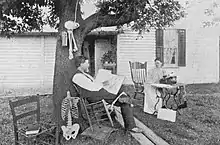Amanuensis
An amanuensis (/əˌmænjuˈɛnsɪs/) is a person employed to write or type what another dictates or to copy what has been written by another, and also refers to a person who signs a document on behalf of another under the latter's authority.[1]

Etymology
From Latin āmanuēnsis (“secretary”), from ab- (“from, off (of)”) + manus (“hand”) + -ensis (“of or from (a place)”), early 17th c.[2]
Uses
It is also used in some academic contexts, when an injured or disabled person is helped by an amanuensis at a written examination. The word was also used when Eric Fenby assisted the blind composer Frederick Delius in writing down the notes that Delius dictated.[3]
In Finland, amanuenssi is an administrative employee of a university, research institution or museum. In Finnish universities, amanuenses can be involved with student guidance counseling, organising course activities, etc.[4]
Job titles
A similar term, Handlanger, exists in German and Dutch (nowadays in both Dutch and German its negative connotation of an unscrupulous, low person acting as criminal assistant prevails whereas the original use of this term for an unskilled and possibly also illiterate person assisting, in the literal sense of lending a hand at construction works has become rather rare).[5]
Notes
- Oxford English Dictionary 3rd ed. (2003)
- "amanuensis", Wiktionary, 2023-03-17, retrieved 2023-08-07
- Eric Fenby (1936) Delius as I Knew Him, G. Bell & Sons, Ltd., London
- "Amanuenssi". jyu.fi. Archived from the original on 2013-12-15. Retrieved 2013-12-15.
- Handlanger, der at duden.de
Further reading
- Aland, Kurt (1961). "The Problem of Anonymity and Pseudonymity in Christian Literature of the First Two Centuries". 12. Journal of Theological Studies: 39–49.
{{cite journal}}: Cite journal requires|journal=(help) - Bahr, Gordon J. (1966). "Paul and Letter Writing in the First Century". 28. Catholic Biblical Quarterly: 465–477.
{{cite journal}}: Cite journal requires|journal=(help) - Bahr, Gordon J. (1968). "The Subscriptions in the Pauline Letters". Journal of Biblical Literature. 2 (1): 27–41. doi:10.2307/3263419. JSTOR 3263419.
- Bauckham, Richard J. (1988). "Pseudo-Apostolic Letters". Journal of Biblical Literature. 107 (3): 469–494. doi:10.2307/3267581. JSTOR 3267581.
- Carson, D.A. (2000). "Pseudonymity and Pseudepigraphy". In Evans, Craig A.; Porter, Stanley E. (eds.). Dictionary of New Testament Background. Downers Grove: InterVarsity Press. pp. 857–864.
- Cousar, Charles B. (1996). "The Letters of Paul". Interpreting Biblical Texts. Nashville: Abingdon.
- Deissmann, G. Adolf. Bible Studies. Trans. Alexander Grieve. 1901. Peabody: Hendrickson, 1988.
- Doty, William G. Letters in Primitive Christianity. Guides to Biblical Scholarship. New Testament. Ed. Dan O. Via Jr. Philadelphia: Fortress, 1988.
- Gamble, Harry Y. “Amanuensis.” Anchor Bible Dictionary. Vol. 1. Ed. David Noel Freedman. New York: Doubleday, 1992.
- Haines-Eitzen, Kim (1998). "'Girls Trained in Beautiful Writing': Female Scribes in Roman Antiquity and Early Christianity". Journal of Early Christian Studies. 6 (4): 629–646. doi:10.1353/earl.1998.0071. S2CID 171026920.
- Longenecker, Richard N. “Ancient Amanuenses and the Pauline Epistles.” New Dimensions in New Testament Study. Eds. Richard N. Longenecker and Merrill C. Tenney. Grand Rapids: Zondervan, 1974. 281–97. idem, “On the Form, Function, and Authority of the New Testament Letters.” Scripture and Truth. Eds. D.A. Carson and John D. Woodbridge. Grand Rapids: Zondervan, 1983. 101–14.
- Murphy-O’Connor, Jerome. Paul the Letter-Writer: His World, His Options, His Skills. Collegeville, MN: Liturgical, 1995.
- Richards, E. Randolph. The Secretary in the Letters of Paul. Tübingen: Mohr, 1991. idem, “The Codex and the Early Collection of Paul’s Letters.” Bulletin for Biblical Research 8 (1998): 151–66. idem, Paul and First-Century Letter Writing: Secretaries, Composition, and Collection. Downers Grove: InterVarsity, 2004.
- Robson, E. Iliff (1917). "Composition and Dictation in New Testament Books". Journal of Theological Studies. 18: 288–301.
- Stowers, Stanley K. Letter Writing in Greco-Roman Antiquity. Library of Early Christianity. Vol. 8. Ed. Wayne A. Meeks. Philadelphia: Westminster, 1989.
- Wall, Robert W. “Introduction to Epistolary Literature.” New Interpreter’s Bible. Vol. 10. Ed. Leander E. Keck. Nashville: Abingdon, 2002. 369–91.
External links
 Media related to Amanuensis at Wikimedia Commons
Media related to Amanuensis at Wikimedia Commons